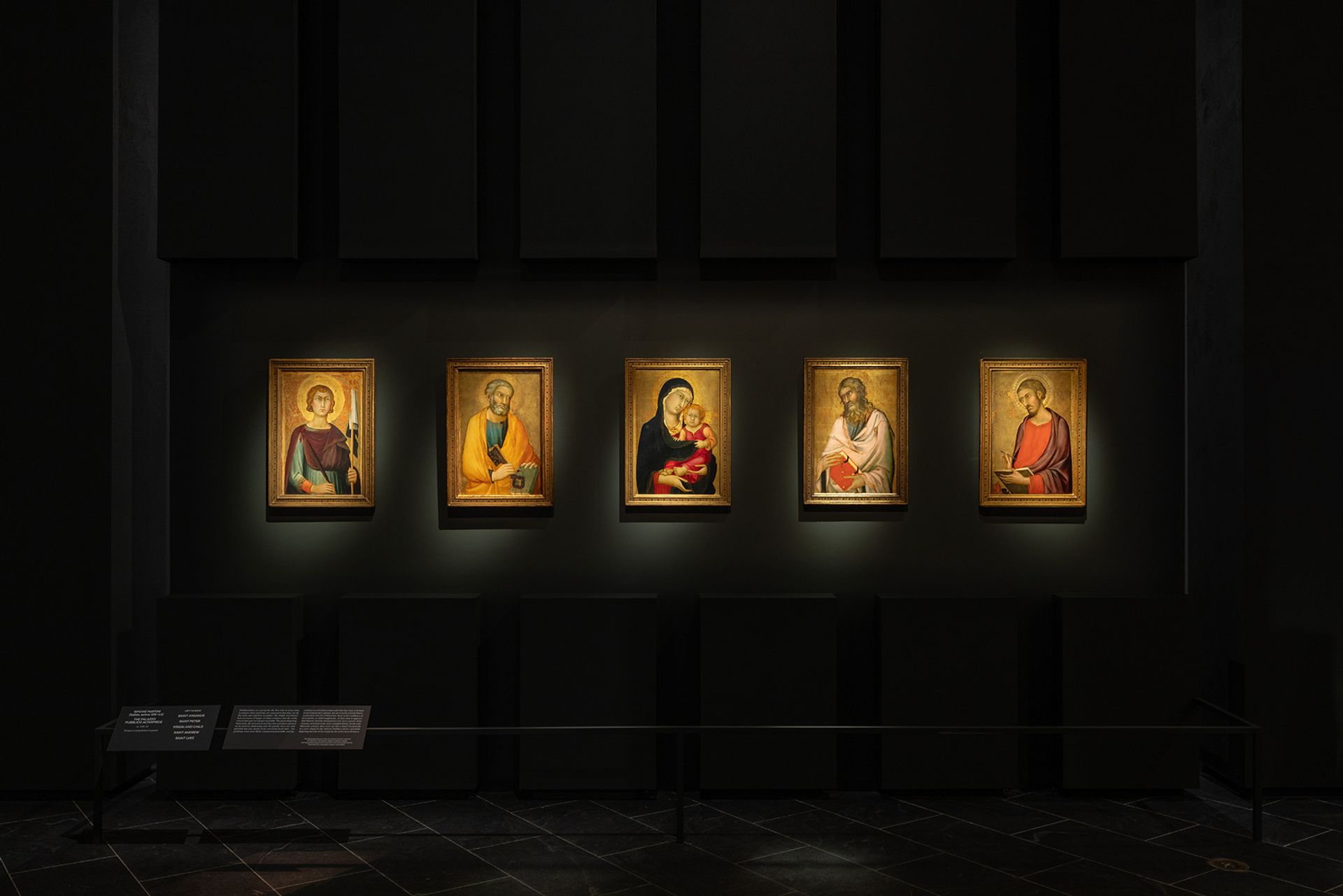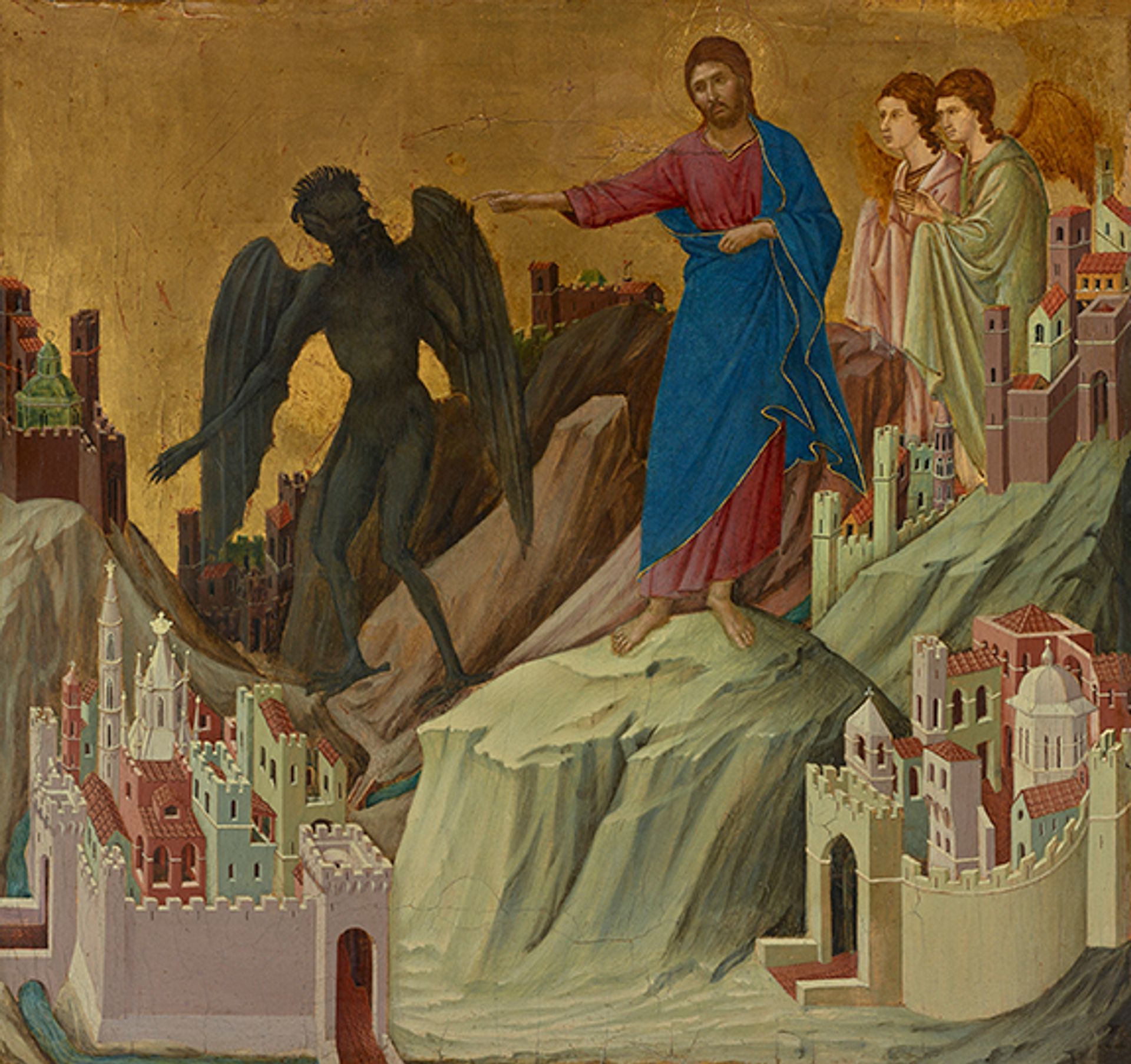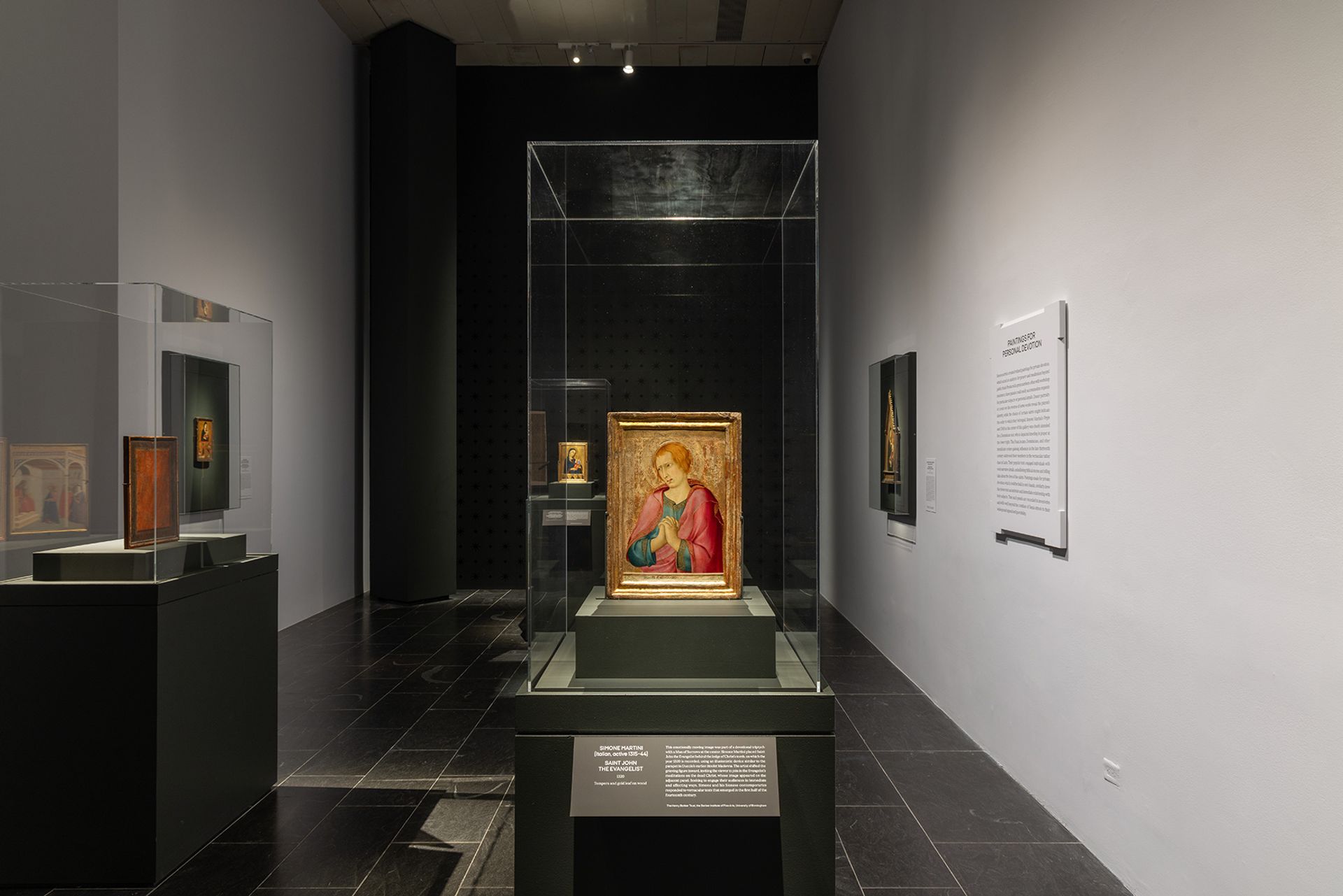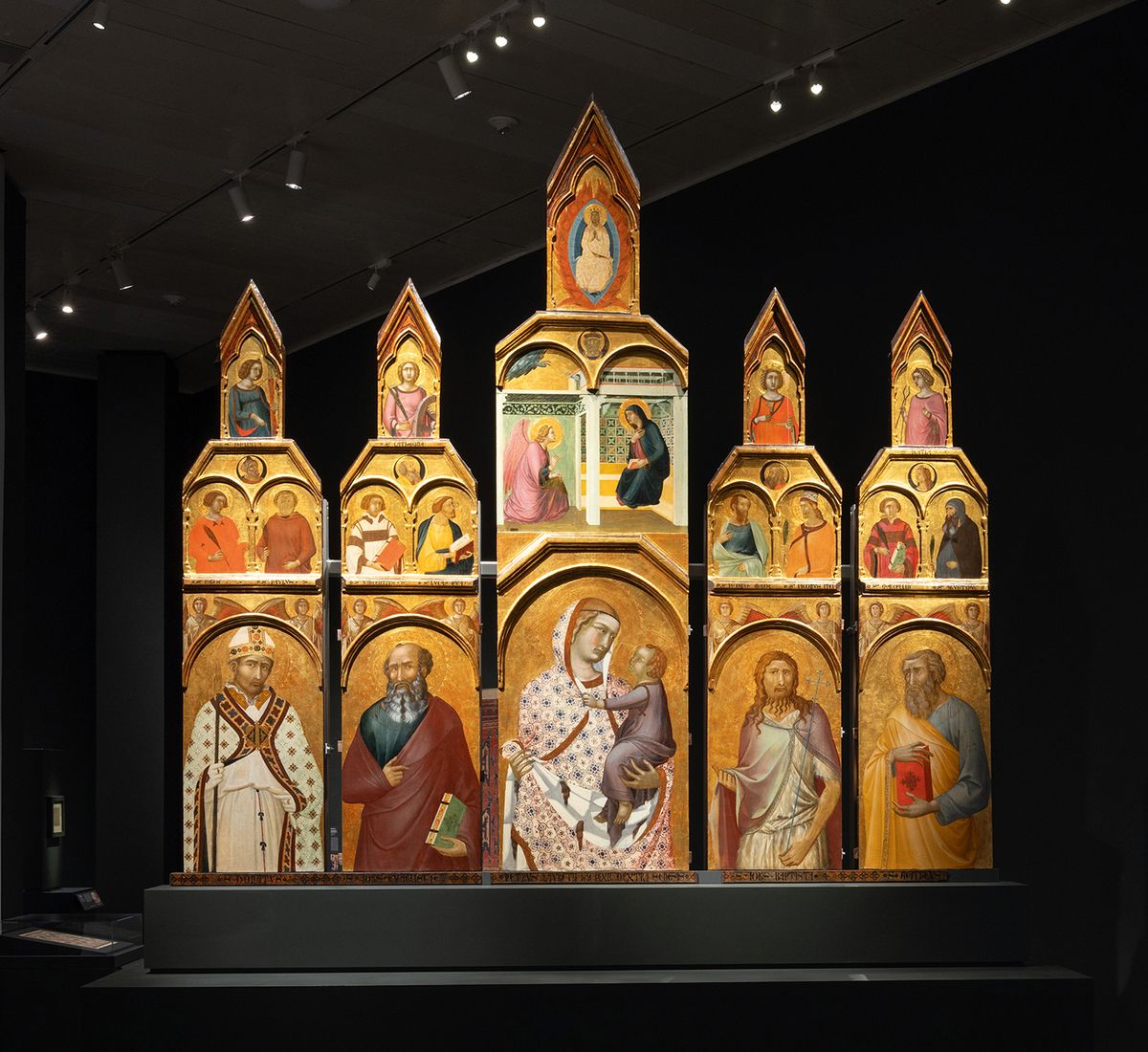Total star rating: ★★★★★
The works: ★★★★★
The show: ★★★★★
The Sienese painter Duccio completed his only signed work, Maestà (majesty), the grand altarpiece for his city’s cathedral, in the baking-hot summer of 1311. This was such a momentous public commission that the whole town downed tools, picked up candles and bells, and followed the picture’s festive procession from the artist’s workshop, outside one of the city gates, to the cathedral.
Imagine the equivalent of a late Medieval open-top bus parade after a city’s team secures the Champions League trophy for the first time. Long before our age of unfettered access to the digital images of collective experience, this was a moment when the people of Siena lived through something that must have felt divinely orchestrated. Above all, the procession of the altarpiece reminds us of the human desire for pageantry and spectacle so that we feel connected to something greater than ourselves.
Parts of the extant Maestà are the centrepiece of the Metropolitan Museum of Art’s exhibition, Siena: The Rise of Painting, 1300-50, the largest and best collection of painting and sculpture from the fiery cauldron of 14th-century Siena that will be staged in our lifetimes.

Next spring, Siena will travel to the National Gallery, London, which was responsible for the loans of several important works
Eileen Travell
Seven years in the making
Siena has been curated by the Met’s Stephan Wolohojian, and Caroline Campbell, a former curator at the National Gallery in London (now the director of the National Gallery of Ireland), who together were part of a small coterie who first conceived of a landmark exposition of early Sienese painting around seven years ago.
It must have felt like a non-starter at the time. To say nothing of the fact that Maestà had been sawn apart in 1771 with 33 elements sold off and eventually squirrelled away into ten collections. Furthermore, many of the works on display, such as Simone Martini’s exquisite Christ Discovered in the Temple (1342) bought in the 19th century for the city of Liverpool, had never left their respective collections. Next spring, Siena will travel to the National Gallery, responsible for loans of important works such as Duccio’s tempera and gold panel The Virgin and Child with Saints Dominic and Aurea (around 1312-15), which has lost little of its detailed vitality more than seven centuries later.

Duccio's The Temptation of Christ on the Mountain (1308–11) is one of the Maestà panels borrowed for the exhibition
Photo: Michael Bodycomb, © The Frick Collection
Liberated madness
That the curators have managed to persuade collectors and conservators to display elements of the Maestà without their frames and their environment-controlled boxes is a major achievement. Liberated and in plain view, we can more closely examine the Bosch-like madness and formal ingenuity of a work like the Frick’s surreal The Temptation of Christ on the Mountain, part of the Maestà, in which Christ and the devil converse, wag fingers, and strut across hilltops populated with miniature cities.
Together with his Florentine rival Giotto, Duccio is the artist who finally put the golden flatness of late Byzantine portraiture to bed and levered open new angles and orthogonal perspectives for painting. It is a double joy to see how Duccio resolved to put his talents in the service of his fantastical imagination over pure geometrical exactitude.
As we might expect, many of the works on display were commissioned for the opulence of the city’s late Medieval Italian cathedral, or else objects for prayer and showing off in the sun-drenched private villas of elite Tuscans. But when entering the exhibition, it feels more like we are ensconced in a sealed vault. It is sombre, dark and hushed. The monastic walls are mostly all black, with only occasional white, a nod to the two-colour Sienese flag, as delicate spotlights illuminate works like a theatre stage.
Five saints
Simone Martini’s polyptych of five saints—including a regret-gauged Saint Peter and a defiant Saint Ansanus, the patron saint of Siena, who was decapitated by order of the Roman emperor Diocletian—is extraordinarily executed and immaculately preserved.
Elsewhere, Pietro Lorenzetti’s Croce Sagomata (silhouetted cross), an enigma insofar as it was too small for the nave of a church and too large for devotional practice, reminded me of the intimate charm of an Alex Katz cut-out. Like Katz, Martini understood how the cut-out form can invite us into space in an entirely different way to a three-dimensional sculpture: against our expectations, we feel even more present in the scene.
While it is a shame that the central panel of the Maestà, showing the Virgin on a marble and mosaic-encrusted throne, could not be prized from Siena’s Museo dell’Opera, Pietro Lorenzetti’s Tarlati Altarpiece (1320), on loan from the Santa Maria della Pieve church in Arezzo, depicts her at the centre of a compelling narrative exposition.

Siena offers a rare glimpse into an entire world when everything seemed possible
Eileen Travell
Black Death
In Siena, the Virgin was venerated not only as the Queen of Heaven but also as a protector of the city, after she was believed to have intervened in the Battle of Montaperti in 1260, one of the bloodiest battles of the time, in which the outnumbered garrisons of Siena routed their Florentine rivals. But even the Virgin could not save Siena from what came next: in 1348, at the peak of its powers, bubonic plague struck the city’s urban areas without mercy.
Duccio, the Lorenzetti brothers, and Martini, who had abandoned Siena for the papal court at Avignon, were all dead by 1350. Siena’s experiment in government, Il Buon Governo—in which local representatives lived together in the Palazzo Pubblico on rotating two-month terms, working under the stare of Ambrogio Lorenzetti’s fresco The Allegory of Good and Bad Government—was not agile enough to respond. Siena lost as much as a half of its population in seven months.
While it is true that Florence suffered a similar fate, that metropolis would soon rebound and eventually thrive as new merchant capital joined the church to prime the pump of an emerging artisan class, paving the way for Fra Angelico and Donatello. This gets close to the argument of the exhibition: just as soon as serendipitous factors coalesce to make one city a thriving centre for art and creativity, unforeseen forces, like a pandemic, can destroy it just as fast. Siena offers a rare glimpse into an entire world when everything seemed possible. Go and see it before it disappears again.
What the other critics said
Holland Cotter, for The New York Times, describes the exhibition as the “art show of the season” and “a visual event of pure 24-karat beauty and a multileveled scholarly coup”.
In The New Yorker, Jackson Arn asks, “Are we looking at perfection or sin? A stately or a casual scene?” before concluding that he loves “how little the Sienese artists bother with smoothing things out, how they wallow in contradiction”.
Ben Davis, for Artnet, celebrates the "tactility" of the “touching” exhibition, while Alex Greenberger, writing for Artnews, describes it as a “superlative show that has the potential to reorder this slice [the Sienese Trecento] of the Western canon.” High praise, indeed.
• Siena: The Rise of Painting, 1300-50, Metropolitan Museum of Art, New York, until 26 January 2025
• Curators: Stephan Wolohojian, Laura Llewellyn and Caroline Campbell
• Tickets: $30 (concessions available)


